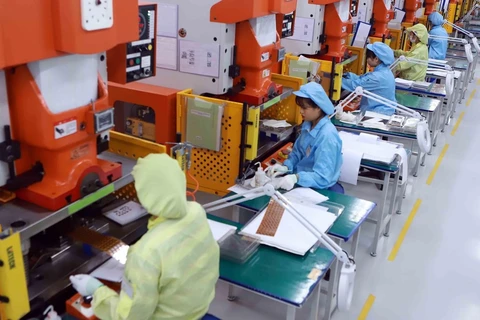Hanoi (VNA) – The number of Vietnamese labourers aged from 15 reached some 51.2 million in the first quarter of this year, up 200,000 as compared with the same period last year, according to the General Statistics Office (GSO).
Of the figure, 50 million people have got jobs, up 132,200 year-on-year, with those working in the service sector making the largest share (38.7 percent), followed by industry and construction (33.5 percent), and agro-forestry-fishery (27.8 percent).
The office said the programme on socio-economic recovery and development in line with Resolution No. 11/NQ-CP with specific measures has warmed up the labour market in the first three months.
Meanwhile, around 1.3 million people were unemployed, down 135,200 from the previous quarter.
Living standards of labourers have been improved and their average income has been restored significantly.
The Business Registration under the Ministry of Planning and Investment said despite severe impacts of the COVID-19 pandemic, business operations have bounced back since December 2021 thanks to the Government’s flexible measures in response to the pandemic.
ILO Vietnam Labour Economist Valentina Barcucci said in 2000, 65.3 percent of the employed labour force was in agriculture. Twenty years later, those two-thirds fell to a little more than one third (37.2 percent). That additional third is roughly split between services and industry.
While in 2000, agriculture was by far the biggest employer in the country, today services and agriculture are virtually equal (37.3 and 37.2 percent respectively), followed closely by the industry sector (25.5 percent of employment).
Of the figure, 50 million people have got jobs, up 132,200 year-on-year, with those working in the service sector making the largest share (38.7 percent), followed by industry and construction (33.5 percent), and agro-forestry-fishery (27.8 percent).
The office said the programme on socio-economic recovery and development in line with Resolution No. 11/NQ-CP with specific measures has warmed up the labour market in the first three months.
Meanwhile, around 1.3 million people were unemployed, down 135,200 from the previous quarter.
Living standards of labourers have been improved and their average income has been restored significantly.
The Business Registration under the Ministry of Planning and Investment said despite severe impacts of the COVID-19 pandemic, business operations have bounced back since December 2021 thanks to the Government’s flexible measures in response to the pandemic.
ILO Vietnam Labour Economist Valentina Barcucci said in 2000, 65.3 percent of the employed labour force was in agriculture. Twenty years later, those two-thirds fell to a little more than one third (37.2 percent). That additional third is roughly split between services and industry.
While in 2000, agriculture was by far the biggest employer in the country, today services and agriculture are virtually equal (37.3 and 37.2 percent respectively), followed closely by the industry sector (25.5 percent of employment).
 Between 2010 and 2020, the Human Capital Index (HCI) value for Vietnam increased from 0.66 to 0.69. (Photo: VNA)
Between 2010 and 2020, the Human Capital Index (HCI) value for Vietnam increased from 0.66 to 0.69. (Photo: VNA) The country will need a new growth model to move out of the risk of a lower middle-income trap and achieve modernisation, industrialisation, as well as sustained growth. This calls for a modernized labour market too, she said.
Labour productivity of the whole economy at the current price is estimated at 171.3 million VND (7,398 USD) per worker, 538 USD higher than that of 2020. The labour productivity in 2021 increased by 4.71 percent due to improved qualifications of workers with the proportion of trained workers with degrees and certificates in 2021 reaching 26.1 percent, higher than the 25.3 percent of 2020.
The productivity, however, is still much lower than that in other countries in the region like Singapore, Malaysia, Thailand and Indonesia, said Bui Quang Tuan, Director of the Vietnam Institute of Economics.
According to the World Bank (WB), between 2010 and 2020, the Human Capital Index (HCI) value for Vietnam increased from 0.66 to 0.69, higher than the average of the countries that have the same income with Vietnam.
Vietnam is one of the countries in East Asia-Pacific that have the highest HCI, reflecting its great achievements in education and health care over the past years, the bank said./.
VNA























